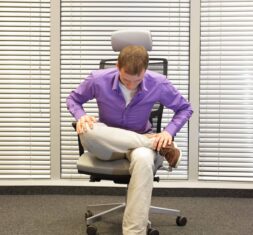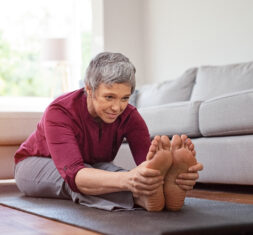Sciatica self care could be top of mind if you are one of the more than 3 million people who suffer from sciatica pain each year. A common condition, sciatica pain is a type of radiculopathy, which is pain caused by a compressed or pinched nerve coming from the spinal cord. Sciatica originates from the largest nerve of the body, the sciatic nerve. The sciatic nerve runs down the lower back area into the buttock and leg.
Known as lumbar radiculopathy because it originates from the lumbar nerves (L4, L5, S1, S2, and S3) in the lower back, sciatica pain can include pain, tingling sensations, or regular discomfort in the lower back or leg. Some patients may even experience sciatica symptoms down in their feet.
The good news is that for many patients sciatica pain can be relieved with self care. In this blog post, I will share some tips about how you can engage in sciatica self care and when it might be appropriate to seek medical care for your sciatica pain.
What is the best thing I can do for sciatica self care?
The best self care people can do at home for sciatica pain is to move. I know that can sound overwhelming, especially if you are in a lot of pain. However, the reality is that movement — specifically stretching and low-impact activities — can make a huge difference. Most people think of movement as walking, biking or hiking, but I strongly suggest starting with simple stretches. The two I recommend you start with are:
- Seated butterfly stretch: Sit with your heels touching and press down lightly on your knees. The seated glute stretch, which is performed in a chair, can be a good variation of this if sitting on the floor is not possible for you. You can also do the butterfly stretch lying on your back.



Knee to opposite shoulder stretch: Lay flat on your back and pull your knee across the opposite side of your body. A variation of this stretch is the knee to chest stretch. The sitting spinal stretch can be a good progression of this stretch, but it’s important that the twisting of the spine doesn’t aggravate your sciatica pain (so this may not be a stretch for everyone with sciatica pain



Start with stretching even if you feel like you cannot move much, if at all. The benefits of stretching are vast, yet too many of us forget to stretch as we age. Stretching strengthens and loosens our muscles and promotes flexibility, which is key to alleviating pain. For deep stretching, warm up your muscles to avoid injuries. I suggest setting a reminder on your phone or in your calendar so that you stretch regularly.
In addition to regular stretching, getting into a pool is a wonderful activity to take the pressure off your back and stretch out your body. Water aerobics, aqua jogging, swimming and walking in the pool can do wonders for sciatica self care.
Outside of the pool, walking, elliptical machines, and exercise bikes are also good options for people looking to move through their sciatica pain.
You should always consult your physician before starting a new exercise program.
Are there any activities I should avoid with sciatica pain?
If you have sciatica pain, I suggest staying away from activities that load weight directly onto your back, including squats, power cleans and bent-over rows. I would also recommend avoiding twisting the back, particularly if you are in a lot of pain. Activities like bending over to weed your garden can even be troublesome to people with sciatica pain.
High impact activities, such as jumping, running and playing football, can make sciatica pain worse. Racket sports, like tennis, that involve twisting can also aggravate sciatica pain. For golfers, work on your short game with small pitches and putts rather than pulling out your driver.
Do ice and heat help with sciatica pain?
Yes, ice and heat can be helpful with sciatica self care. Ice reduces inflammation, and heat increases blood flow and loosens the muscles. Both ice and heat can soothe pain and promote healing. In general, ice is usually recommended when you first have pain. Alternate with ice on for 20-30 minutes and then off for 20-30 minutes, and never put ice directly on your skin.
Heat is usually most helpful after the initial onset of pain. I recommend the same 20-30 minutes on and 20-30 minutes off routine. If either cold or heat are painful, you should stop using them. And be sure to never fall asleep with either as it can cause additional issues.
Some patients find relief with lidocaine patches or heat patches, which allow for mobility while you are using them. If you try a patch and it doesn’t provide relief, you likely won’t benefit from that type of patch.
Are there other sciatica self care things I can do to help reduce my pain?
Many patients benefit from massage or acupuncture therapy to relieve their sciatica pain. Based on your diagnosis, your physician may also recommend physical therapy, improving your posture, or losing weight. Over-the-counter medications may also help relieve sciatica pain.
When should I consult a neurosurgeon about my sciatica pain?
Most patients do not need to see a neurosurgeon for sciatica pain. However, if you have very consistent shooting pains down your leg or if your pain turns into numbness, you should schedule an appointment with a neurosurgeon.
If you have new sciatica pain, I suggest you try a combination of alternating ice and then heat and stretching. Gradually increase your stretching, if possible, and engage in low-impact activities, such as swimming or biking. Continue with your sciatica self care as long as your symptoms improve.
You know your body better than anyone, so if something feels off or unusual, it is best to consult with your physician. You also might benefit from spinal injections or other pain management procedures we offer at Neurosurgery One.
Should I go to the ER for sciatica pain?
In general, most patients do not require emergency care for sciatica — even if you are experiencing severe pain. However, there are exceptions we call “red flag symptoms.” If you are experiencing any of the following, you should seek emergency care immediately as these symptoms indicate problems that can cause permanent disability:
- Loss of sensation or movement in your legs
- Loss of bladder or bowel control
- Fever or chills
- Numbness in your groin area
Read more about when to go to an ER for back pain in my colleague’s blog post.



